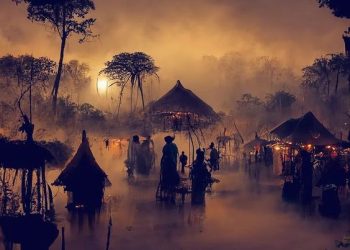Jakarta, Indonesia Sentinel — Indonesia is home to numerous indigenous communities, each with its own unique wisdom. One of these is the Kajang tribe, a community in South Sulawesi that plays a significant role in environmental conservation. With a deep-rooted belief in the vital role of forests in sustaining life, the Kajang people has been recognized as one of the world’s best forest guardians..
For the Kajang tribe, the forest holds both ritualistic and ecological significance. They believe the forest is sacred, as it is where the Earth was first created. This sacred space is where they perform various traditional ceremonies. Beyond its spiritual role, the forest is also viewed as a vital source of rain and water (known as tumbusu’) for the Kajang people.
These dual roles of the forest shape how the Kajang tribe treats and protects it, adhering to strict traditional regulations overseen by their customary leader, the Ammatoa. The tribe’s environmental philosophy is deeply intertwined with their cultural laws, particularly the Pasang ri Kajang, which is an oral system of knowledge, messages, and laws passed down through generations. Pasang serves as the highest guiding principle for the Kajang people and must not be violated.
A key element of their conservation efforts is the cultural philosophy of Kamase-masea, which teaches simplicity and moderation. This belief drives the Kajang people to manage their natural resources in a way that maintains ecological balance. One of the ways this is achieved is through the division of their forests into two distinct areas, as regulated by the Ammatoa:
- Sacred Forest (Borong Karamaka) – This area is strictly protected, where no activities are allowed except for ritual ceremonies. Cutting trees, measuring land, or any activity that disturbs the flora and fauna is forbidden. Anyone who violates these rules is fined and required to return any taken wood to the forest.
- Boundary Forest (Borong Batasayya) – In this area, certain trees can be harvested, but only with the permission of the Ammatoa and as long as resources are still available. The harvested wood is used solely for specific purposes, such as building community infrastructure or homes for those in need.
This division of forestland is a prime example of the Kajang people’s sustainable approach to environmental management.
Mark Zuckerberg Predicts Smart Glasses Will Overtake Smartphones in the Future
In addition to their forest management practices, the Kajang tribe has a wealth of rituals and traditions related to nature conservation. Whenever they harvest forest products, they hold thanksgiving ceremonies to honor and seek blessings from ancestral spirits, ensuring that the balance of nature remains intact.
This practice instills a deep spiritual awareness of humanity’s relationship with the environment. The Kajang tribe also plays an important role in educating the younger generation about the importance of protecting the forest. Conservation knowledge and values are passed down through storytelling, songs, and everyday practices. This environmental education serves as the foundation for the Kajang tribe’s ongoing conservation efforts.
Through their traditional wisdom and sustainable practices, the Kajang tribe continues to play an important role in conservation. While their beliefs and traditions remain a model for environmental management, inspiring the future generations.
(Raidi/Agung)

























